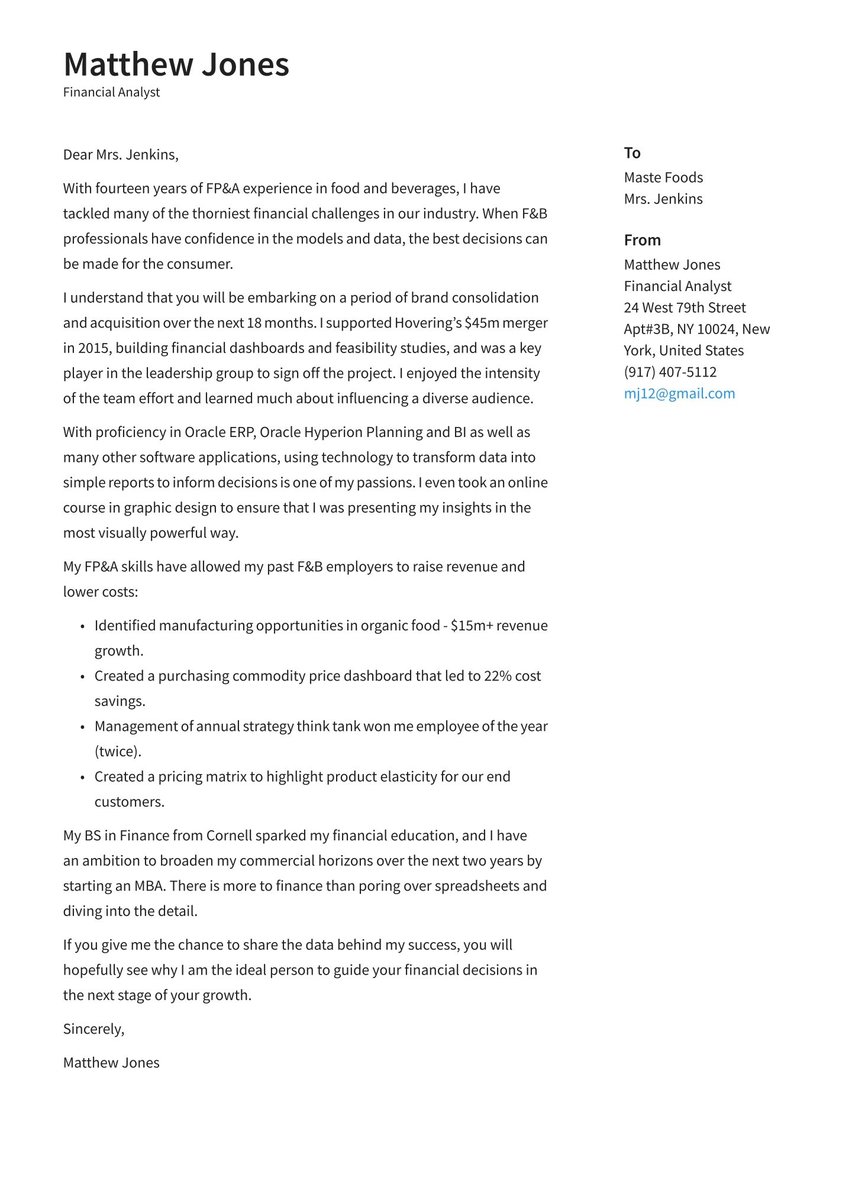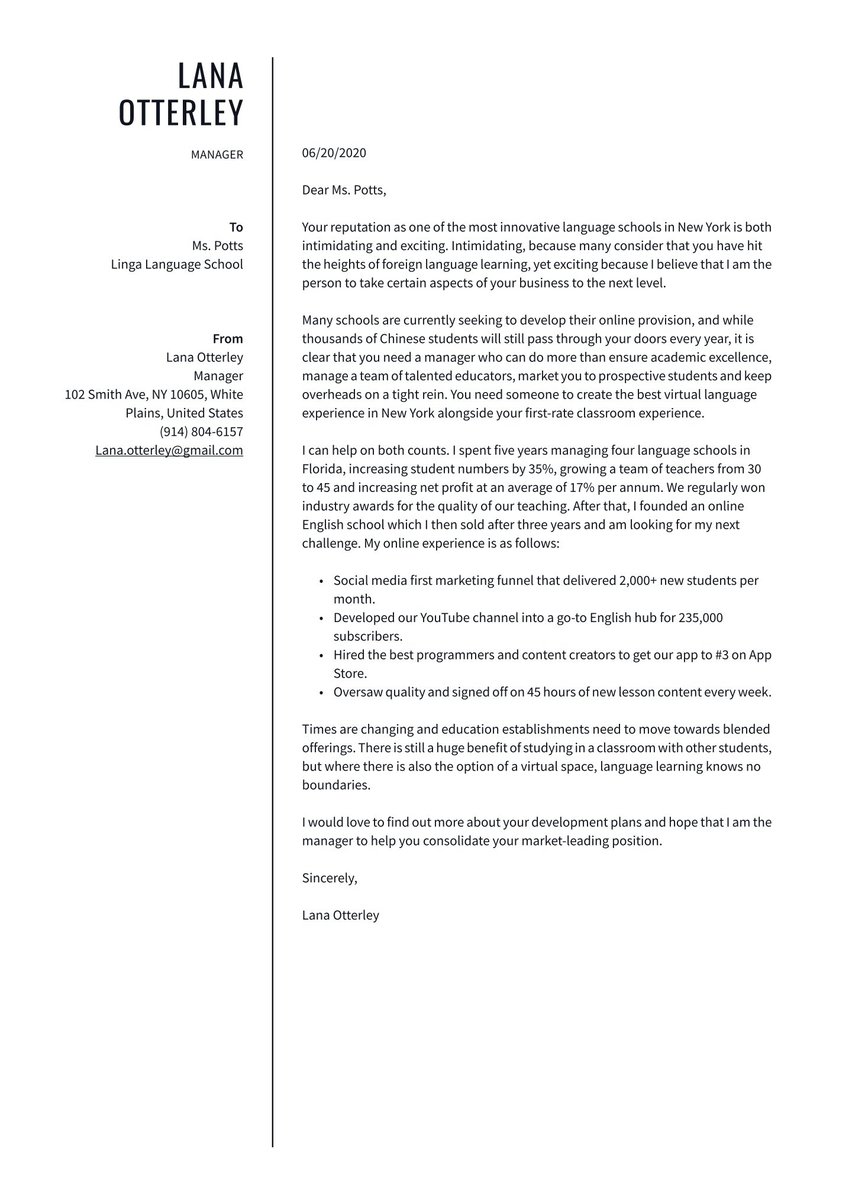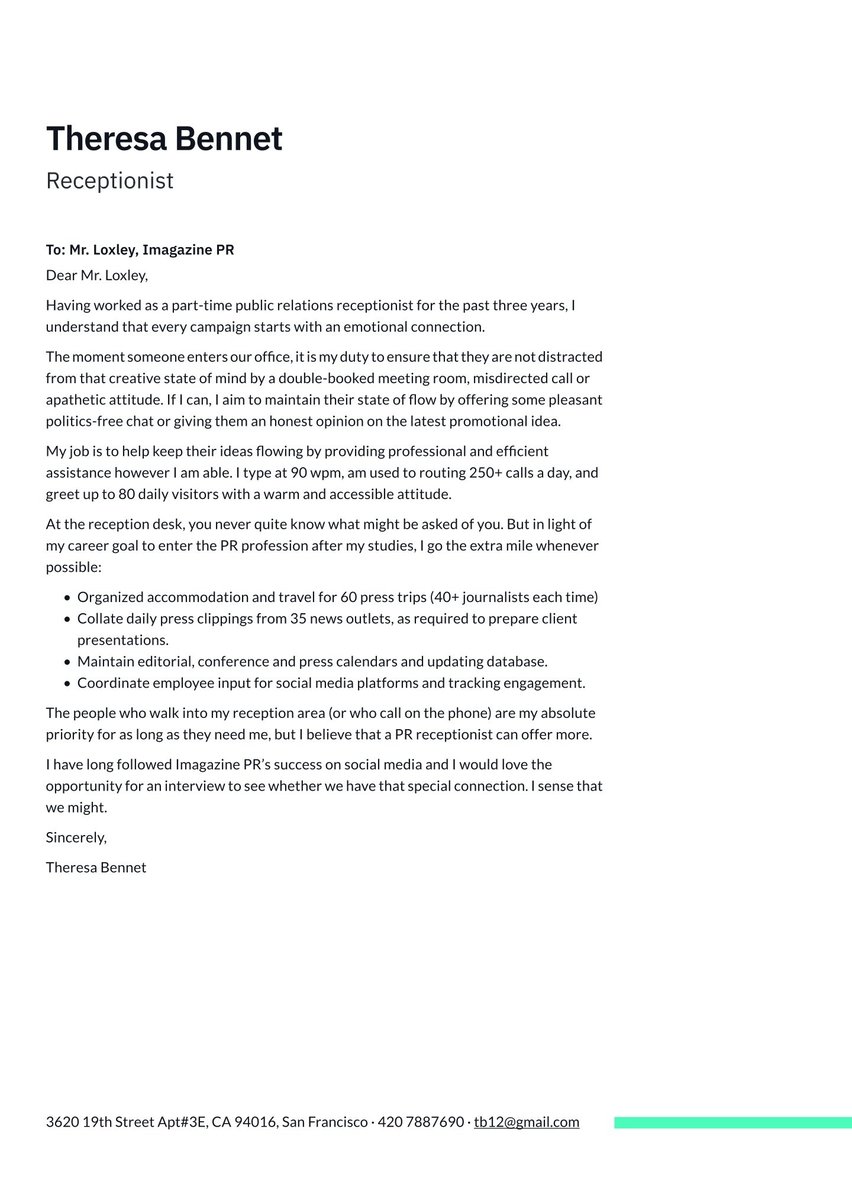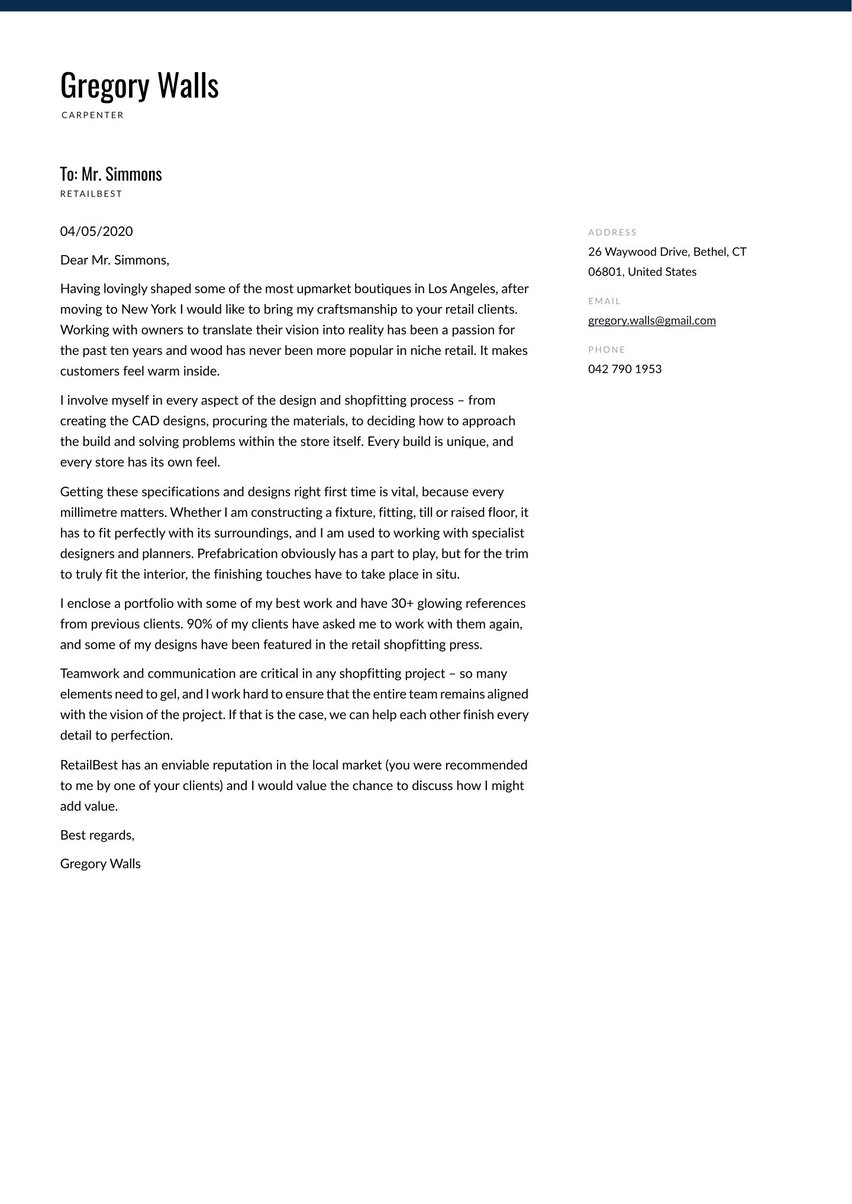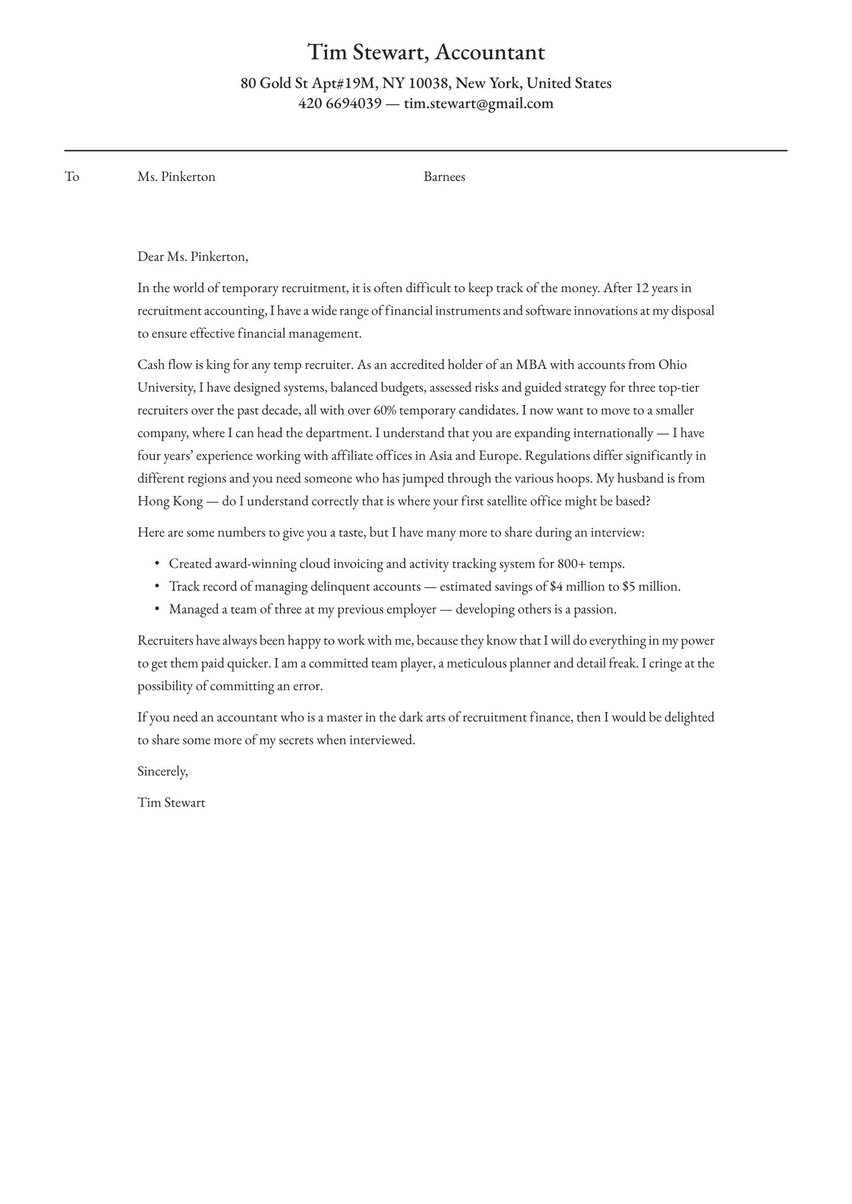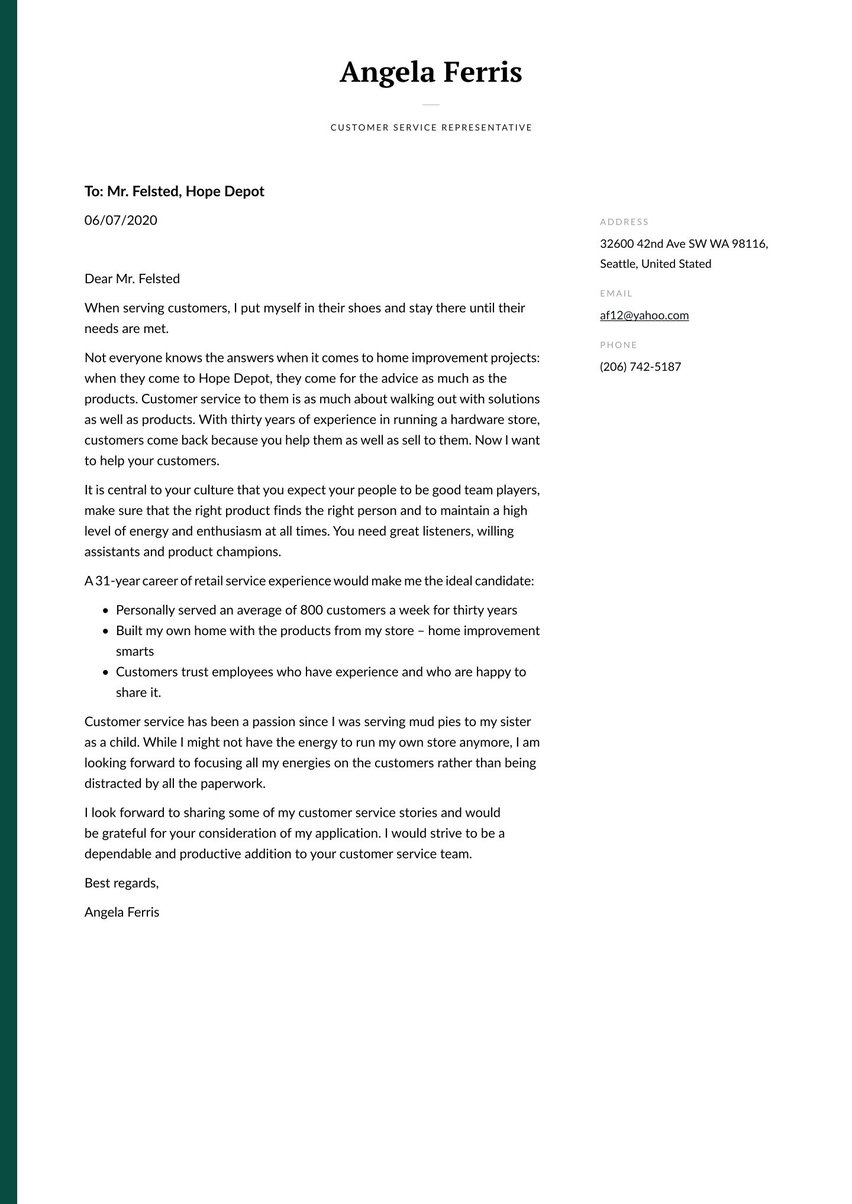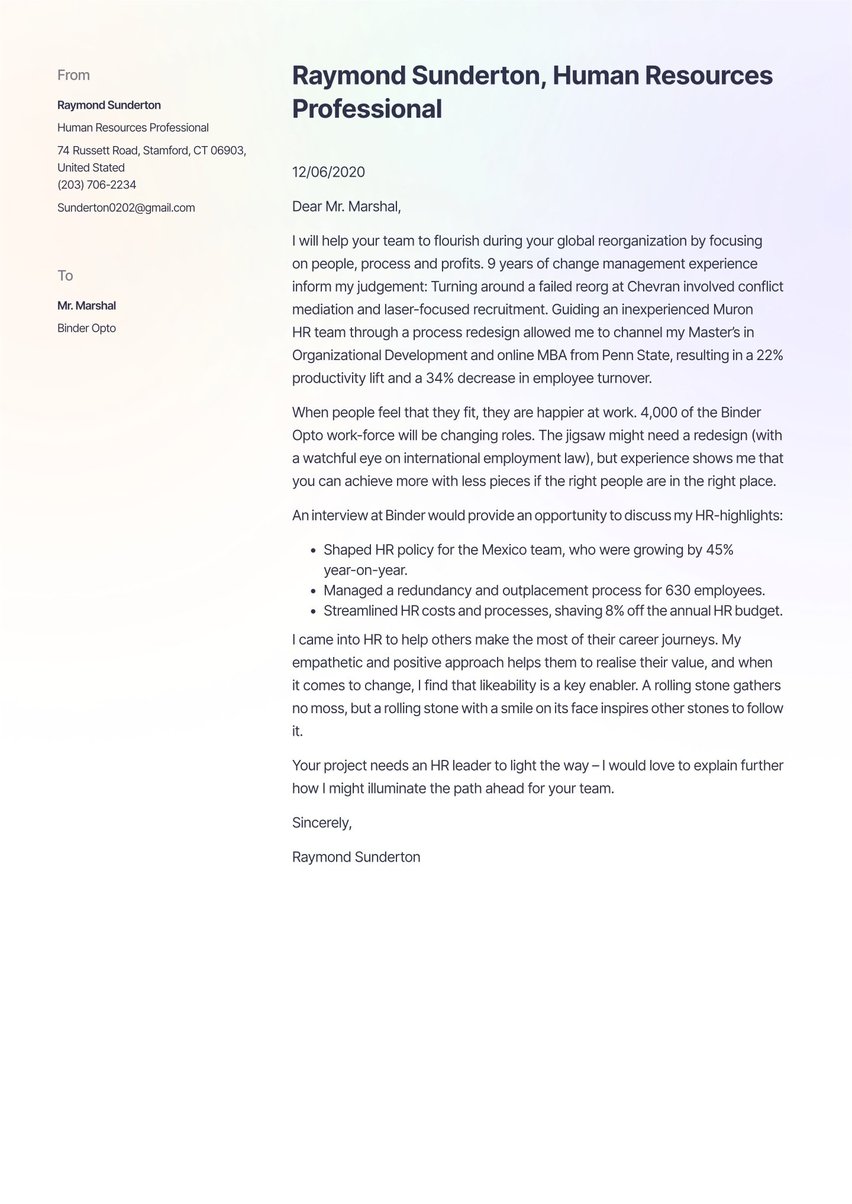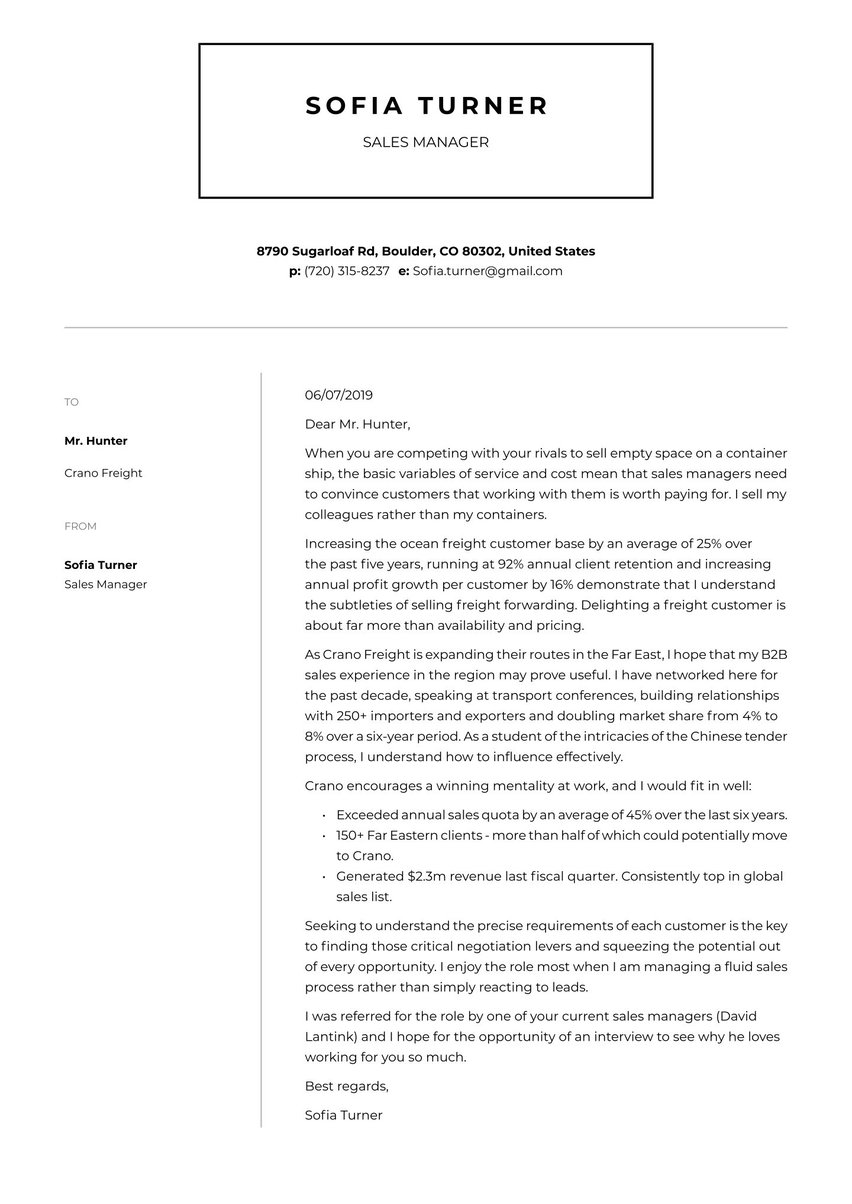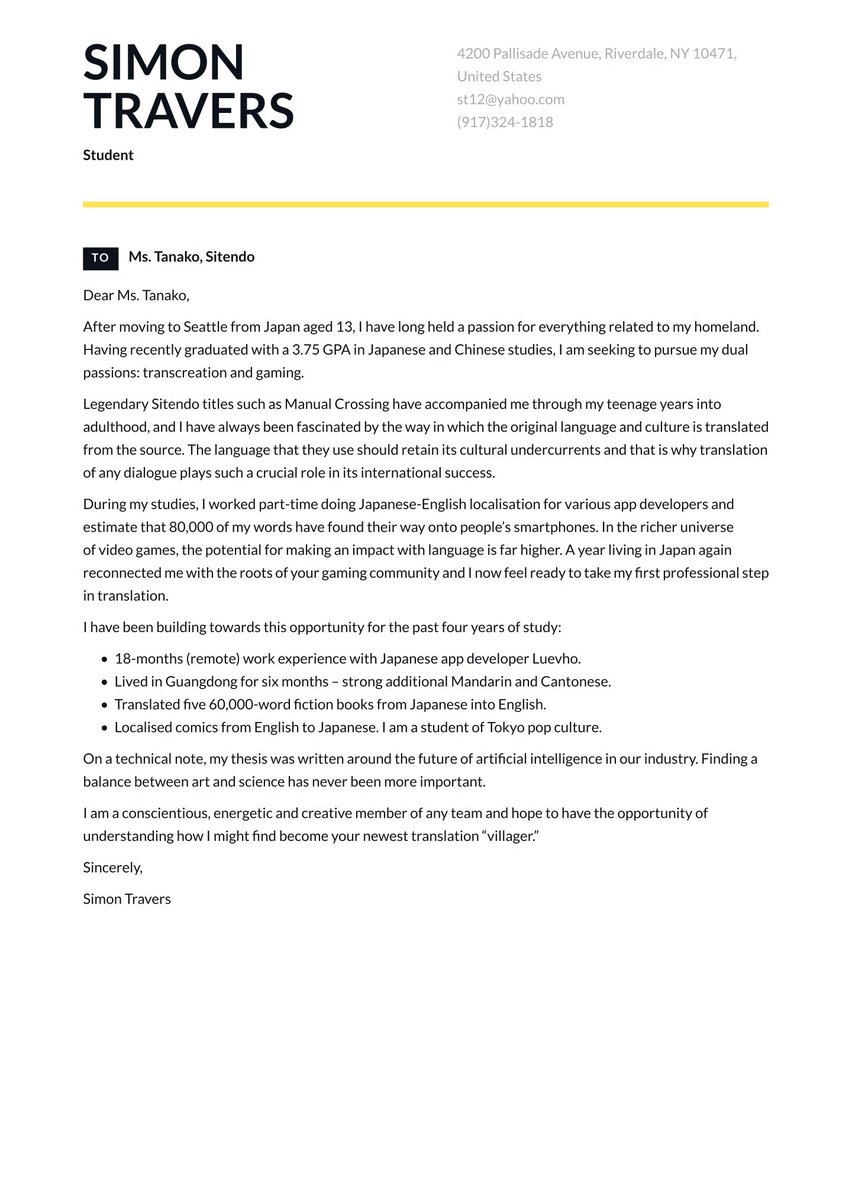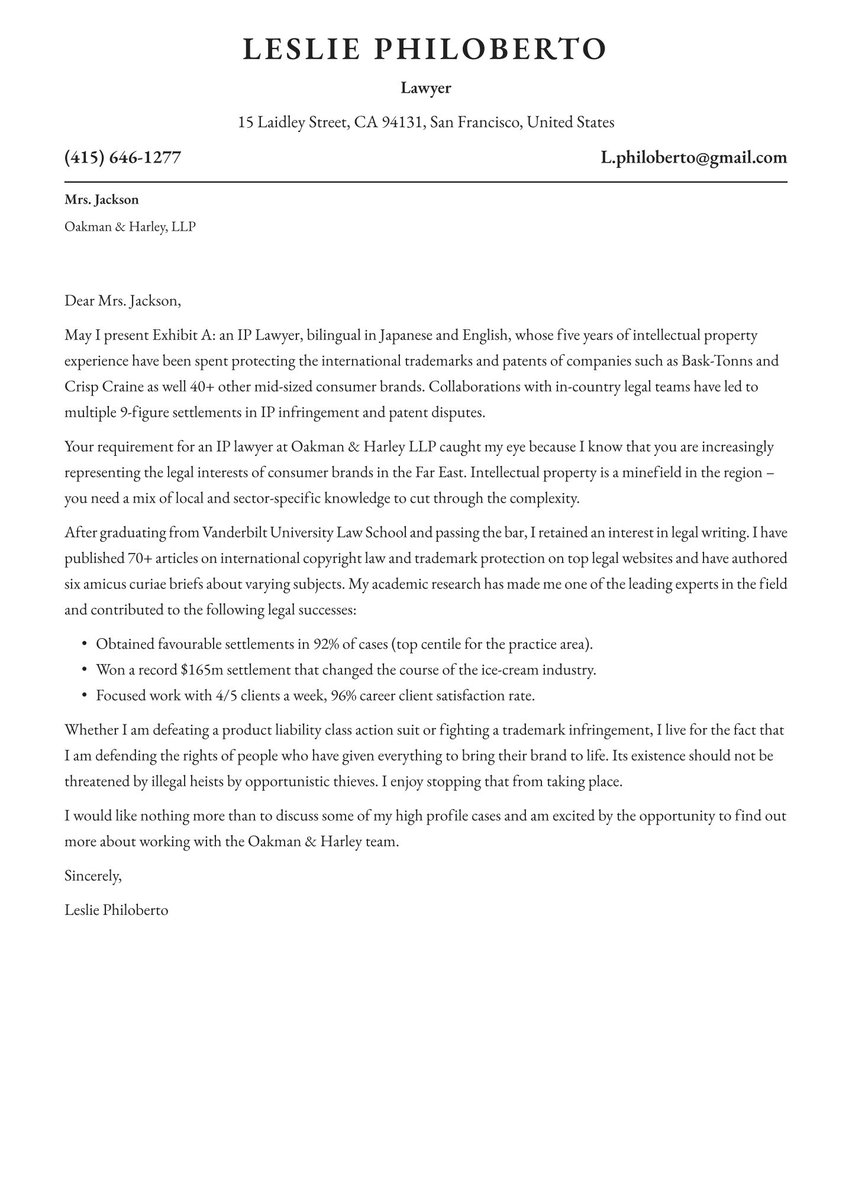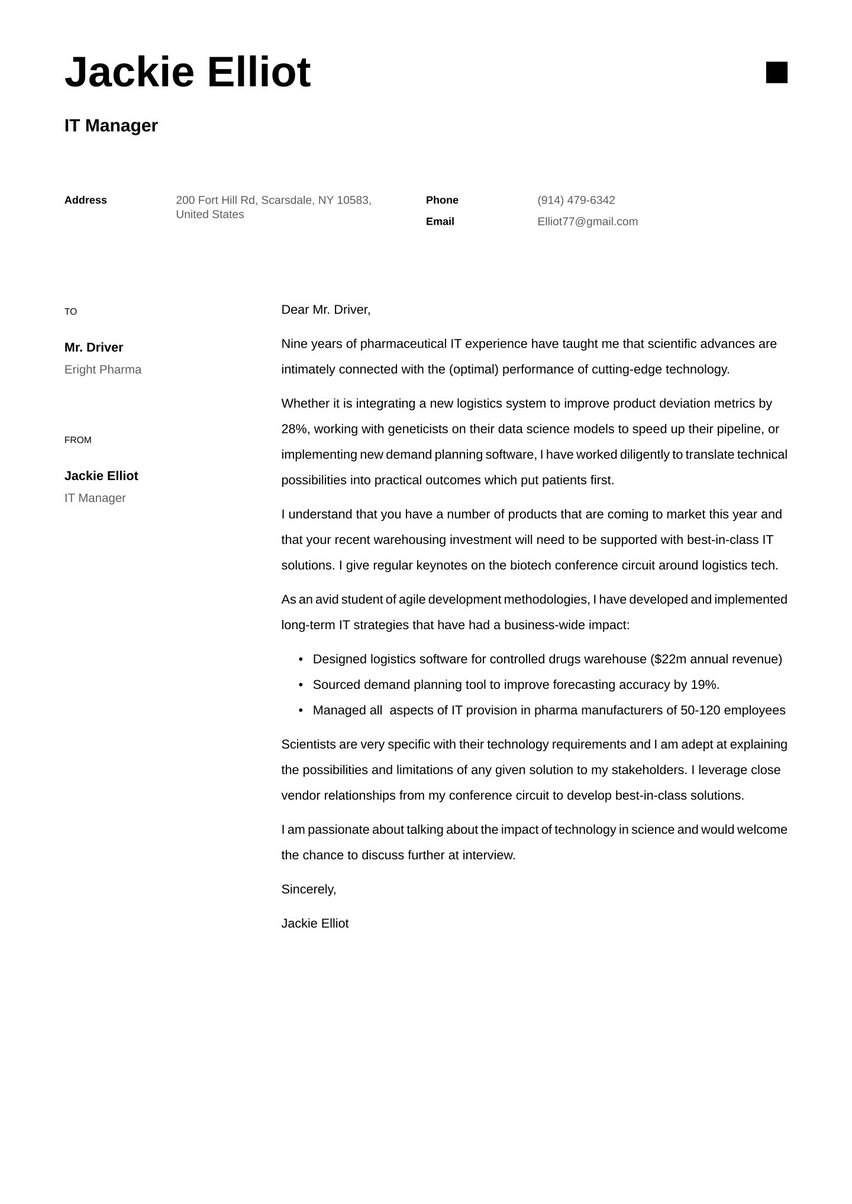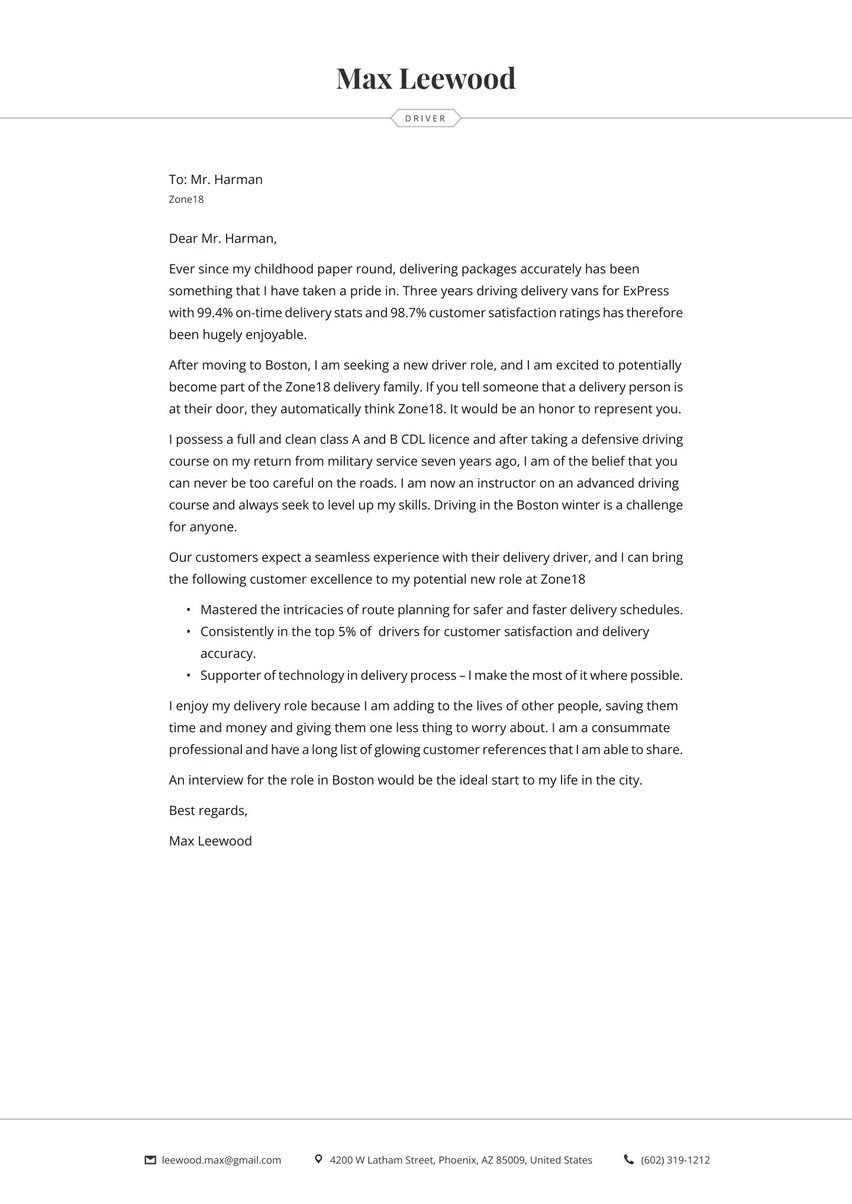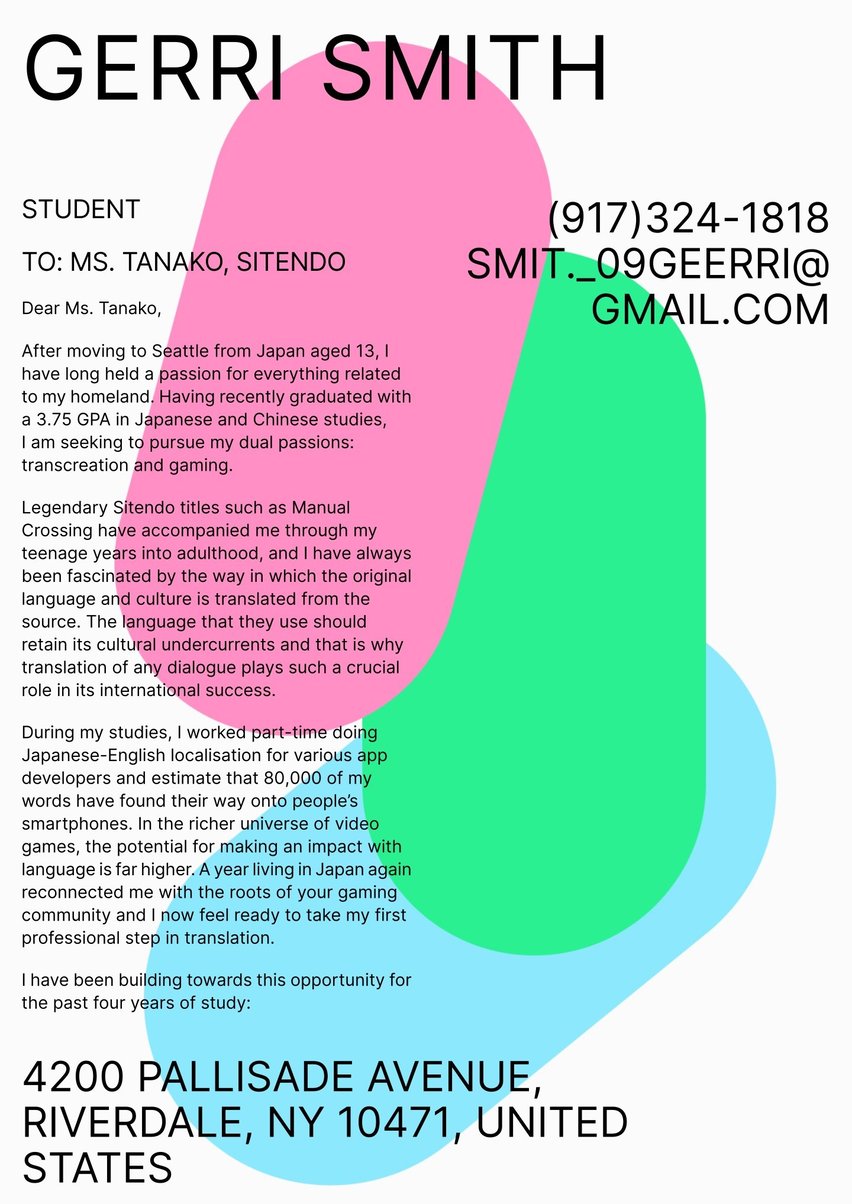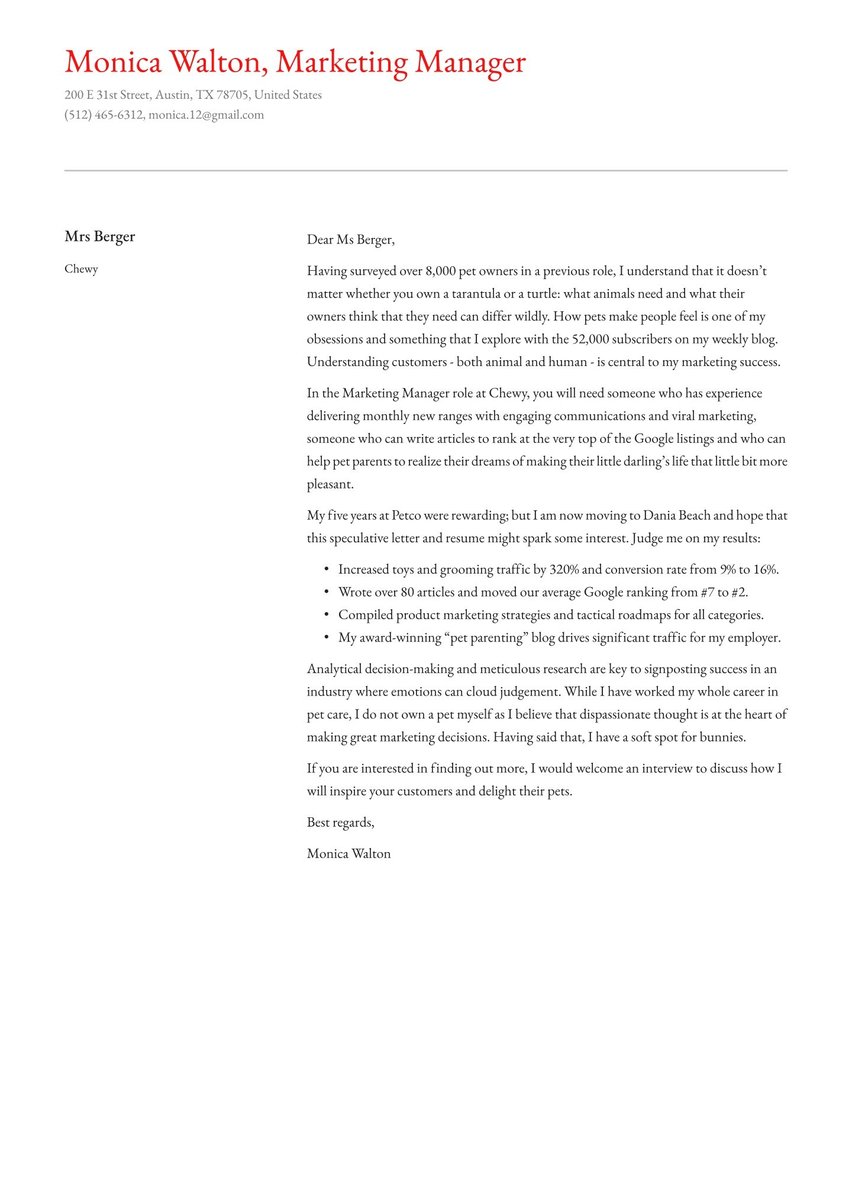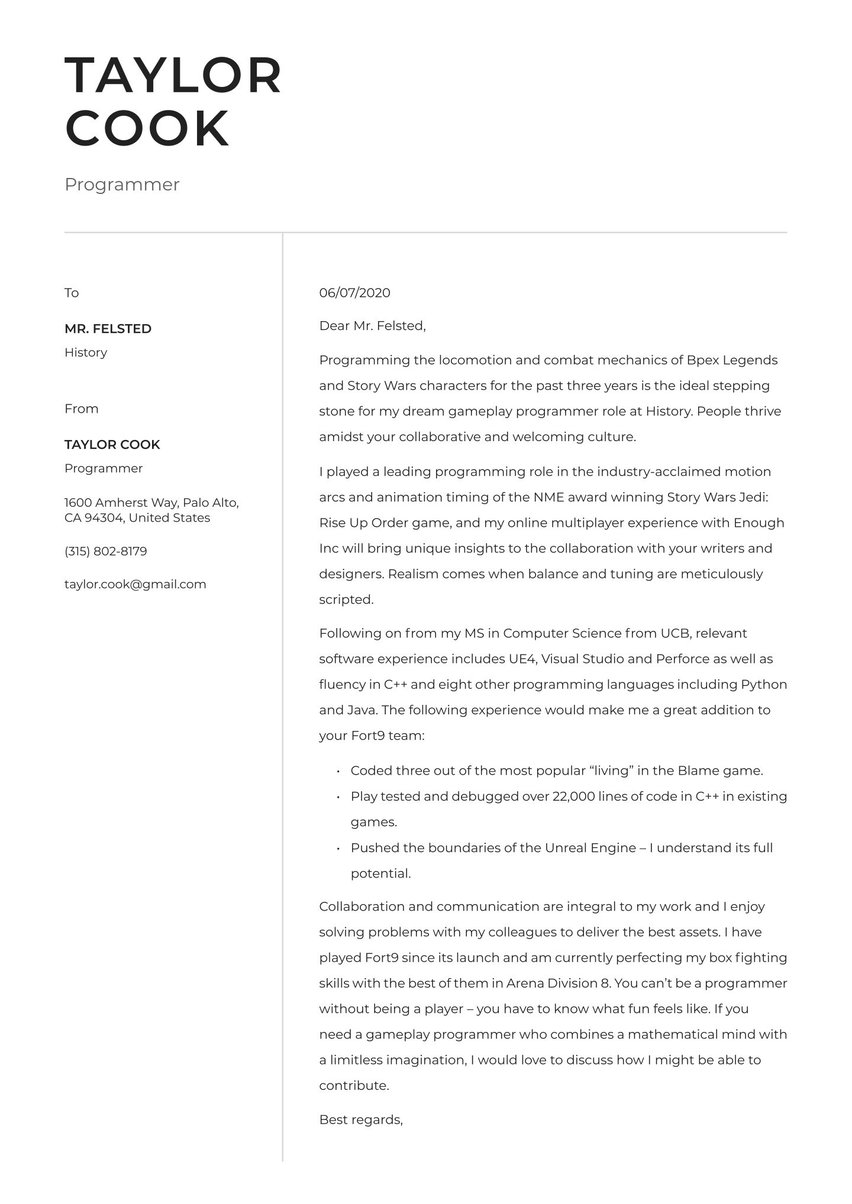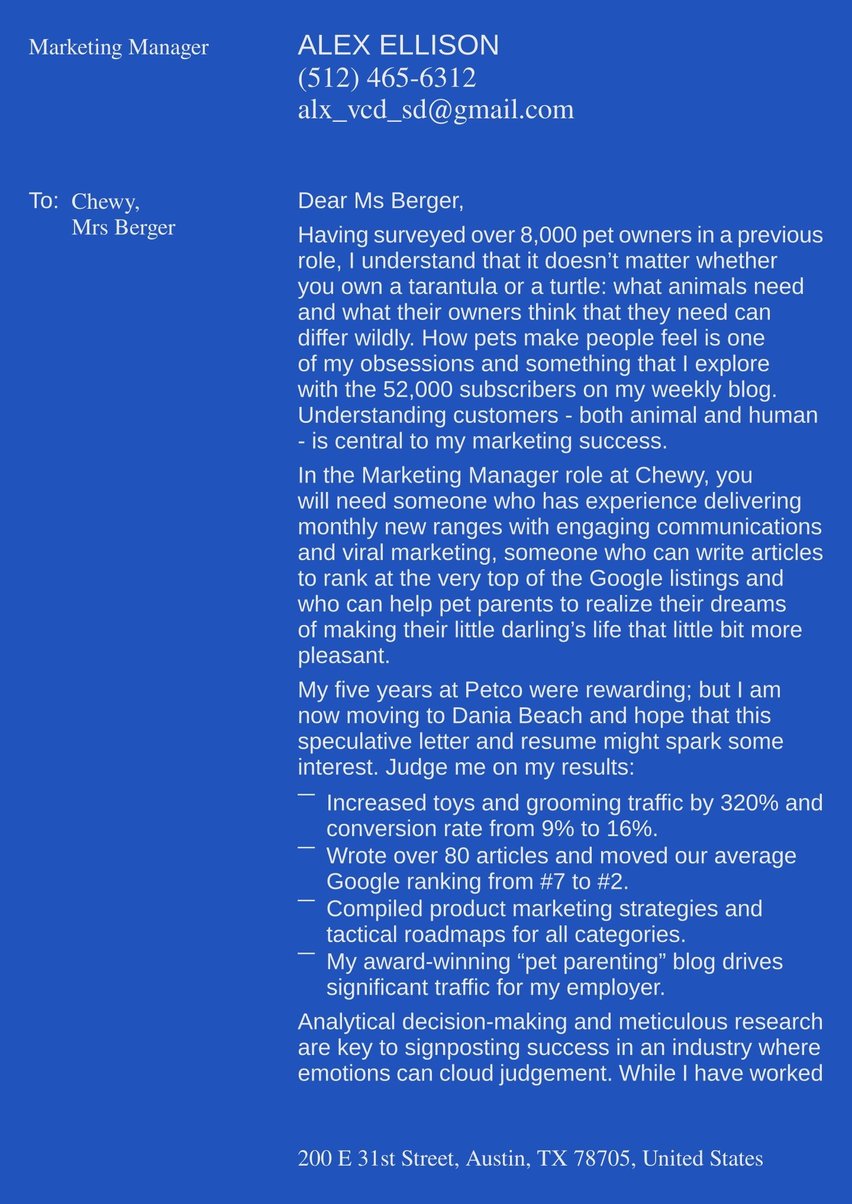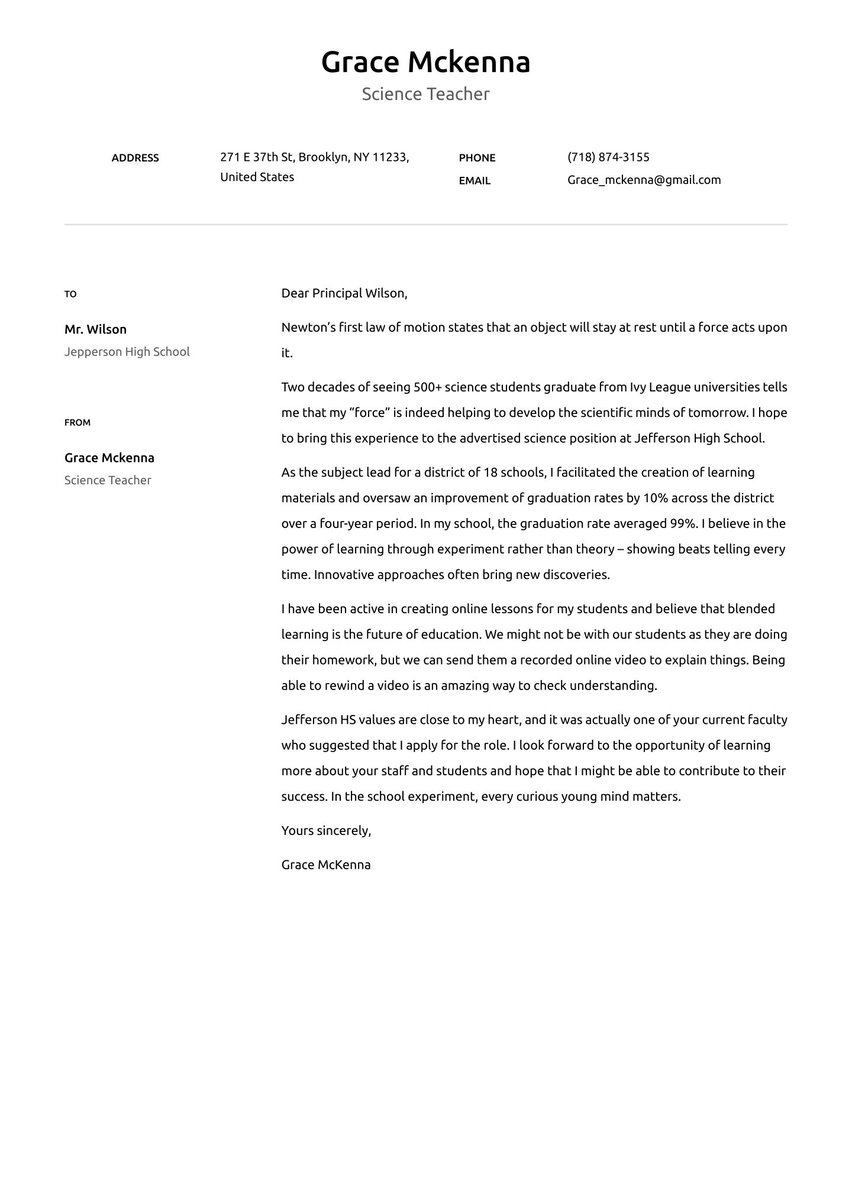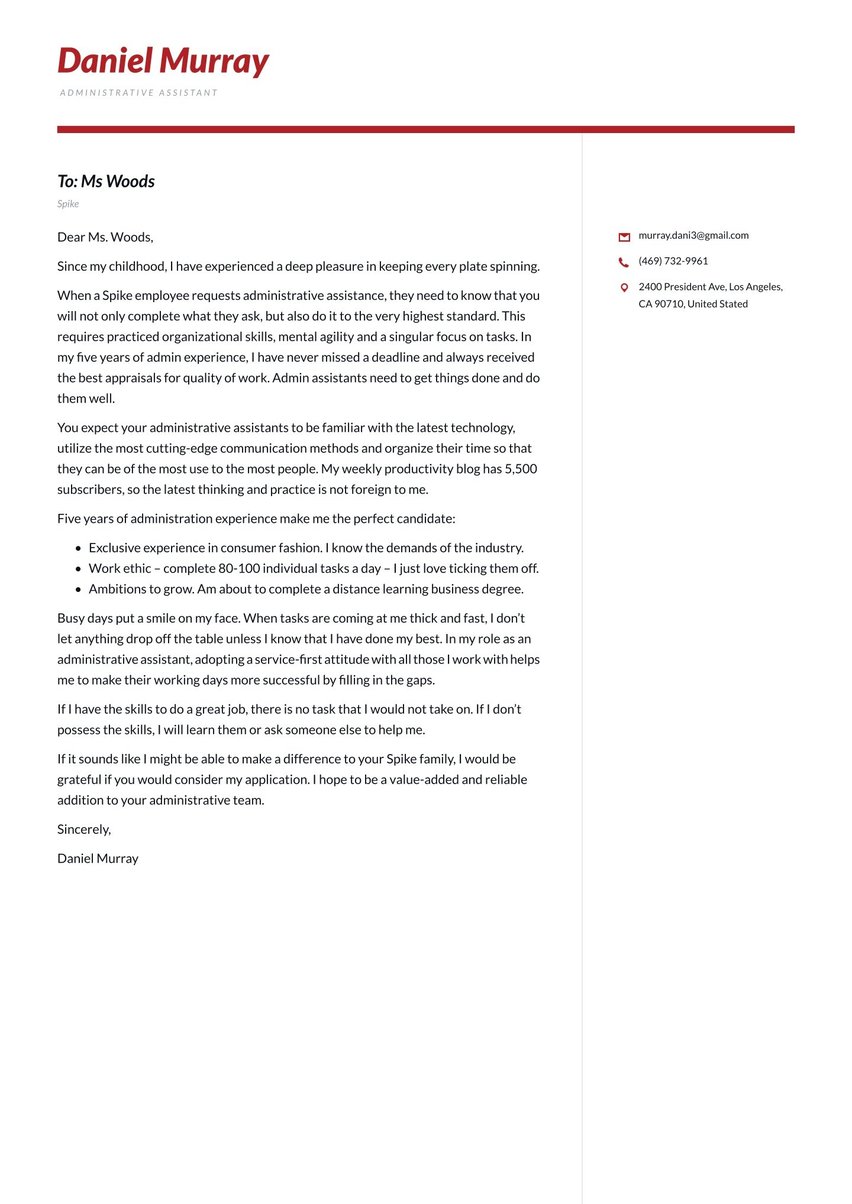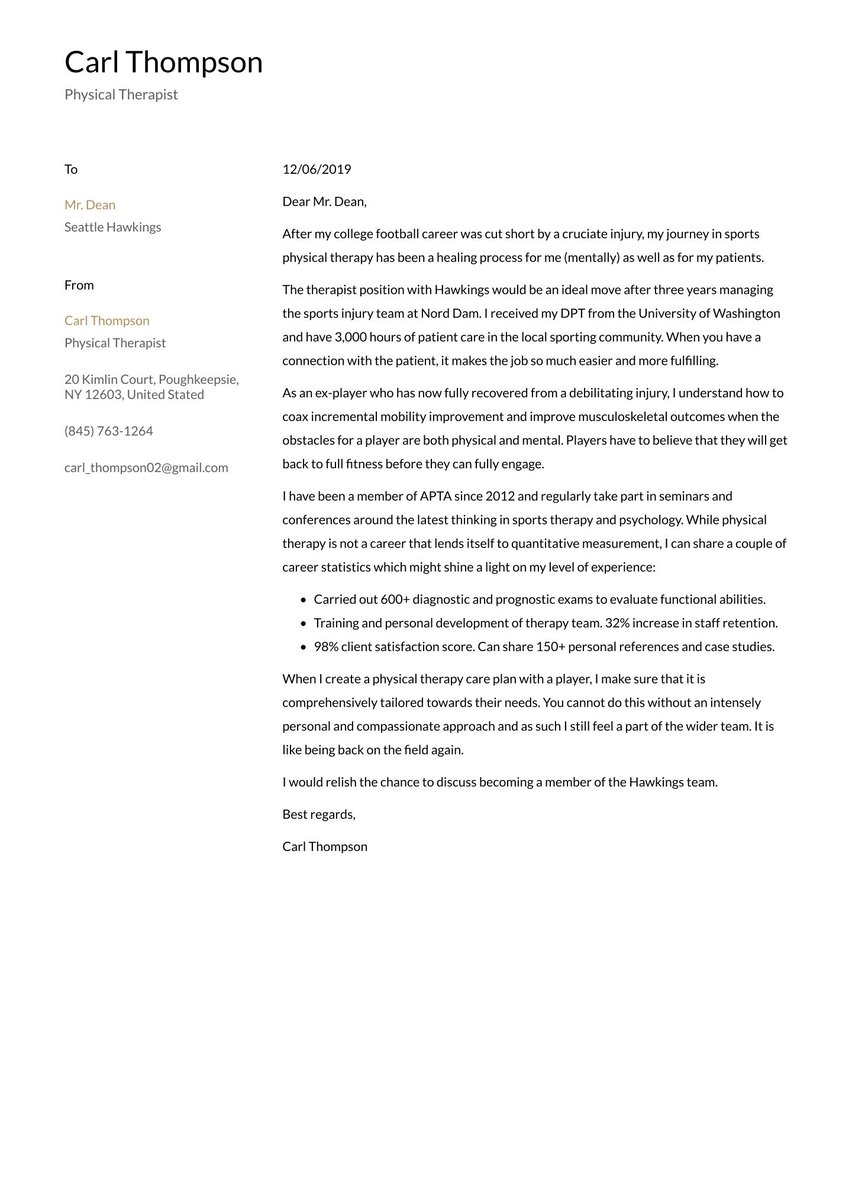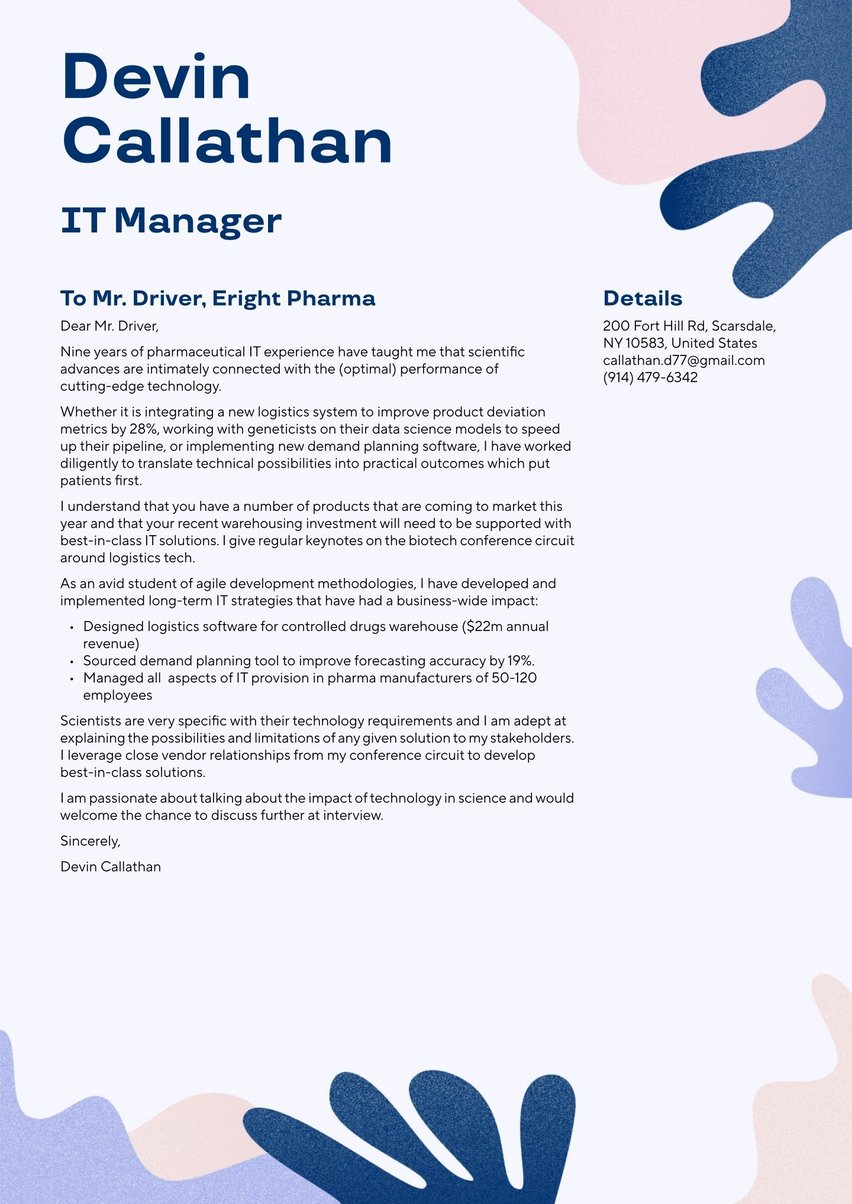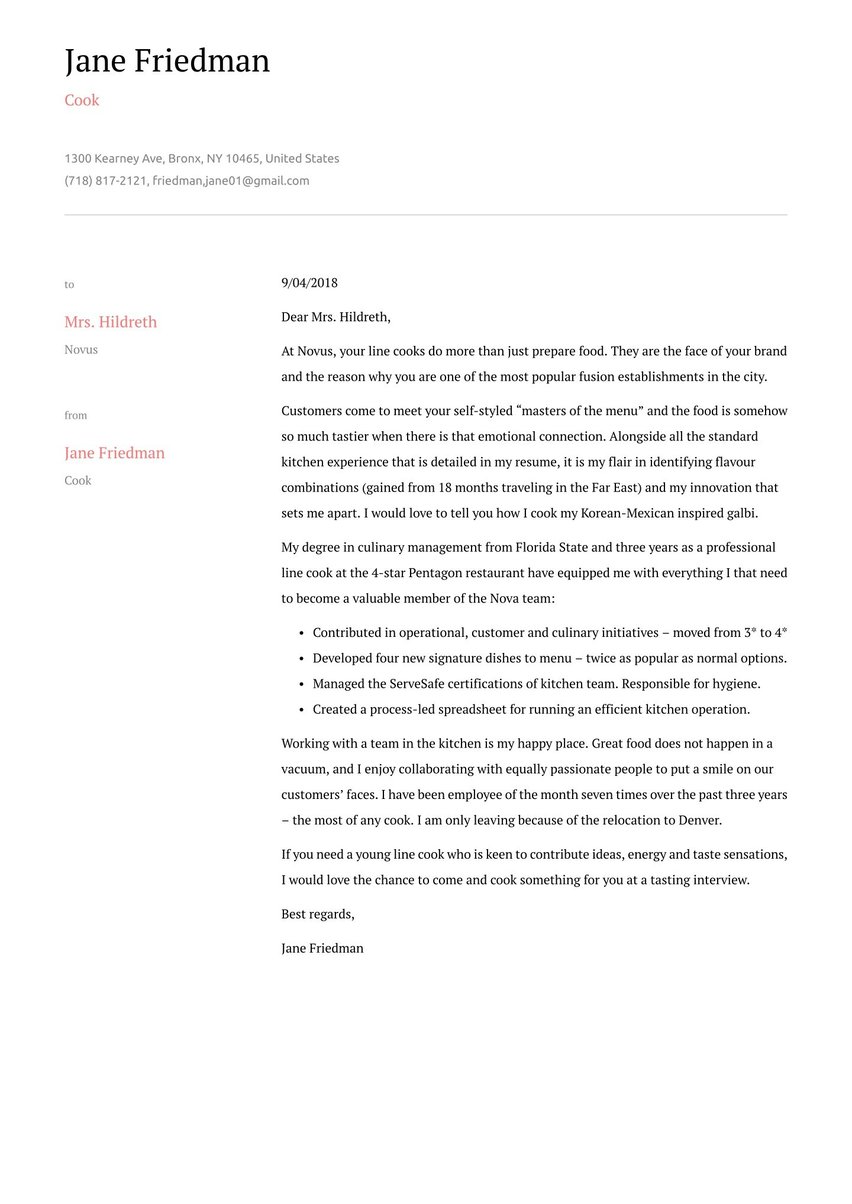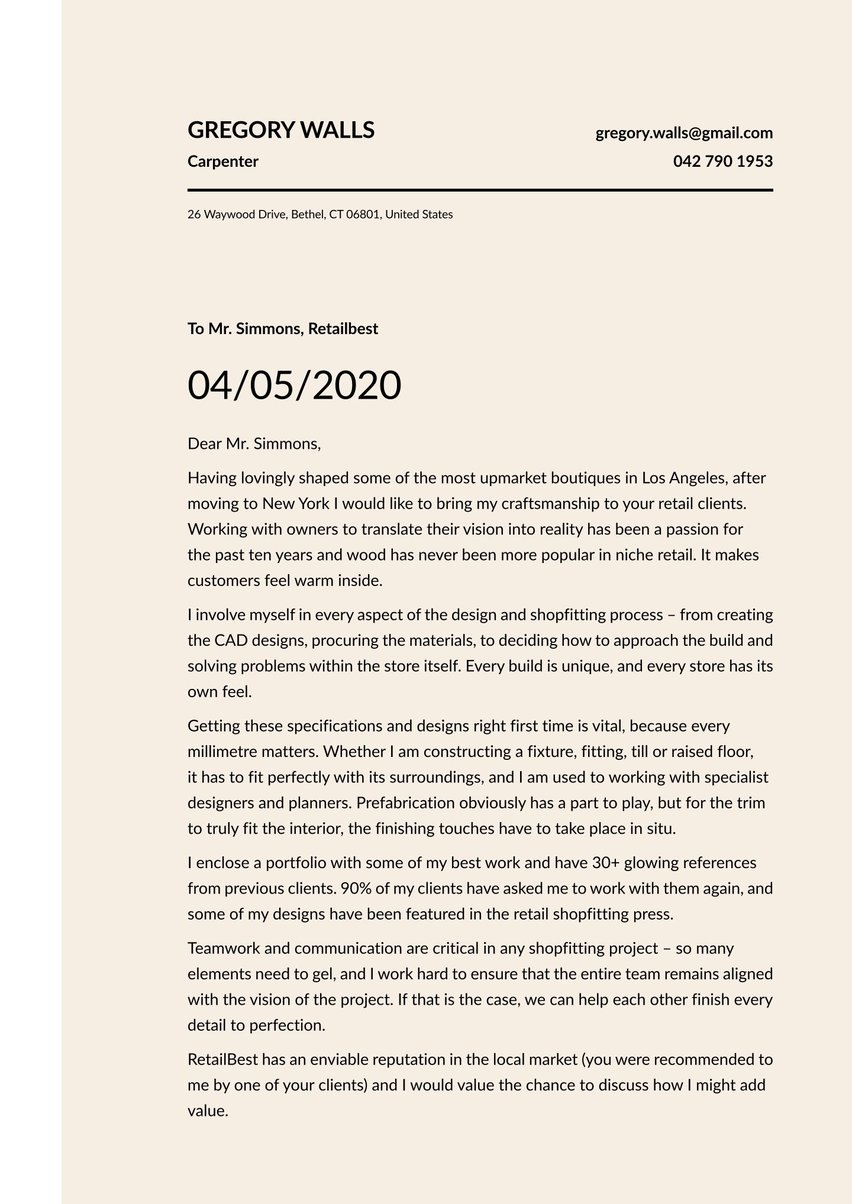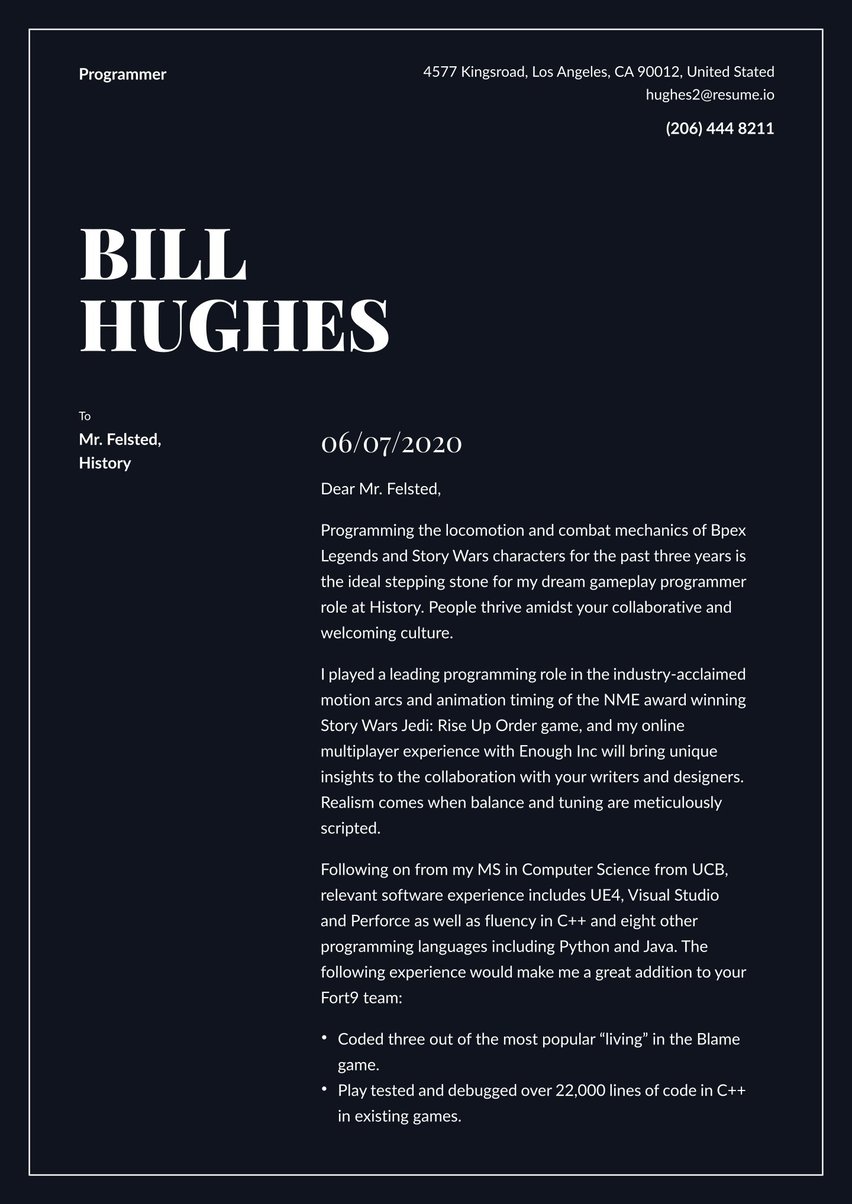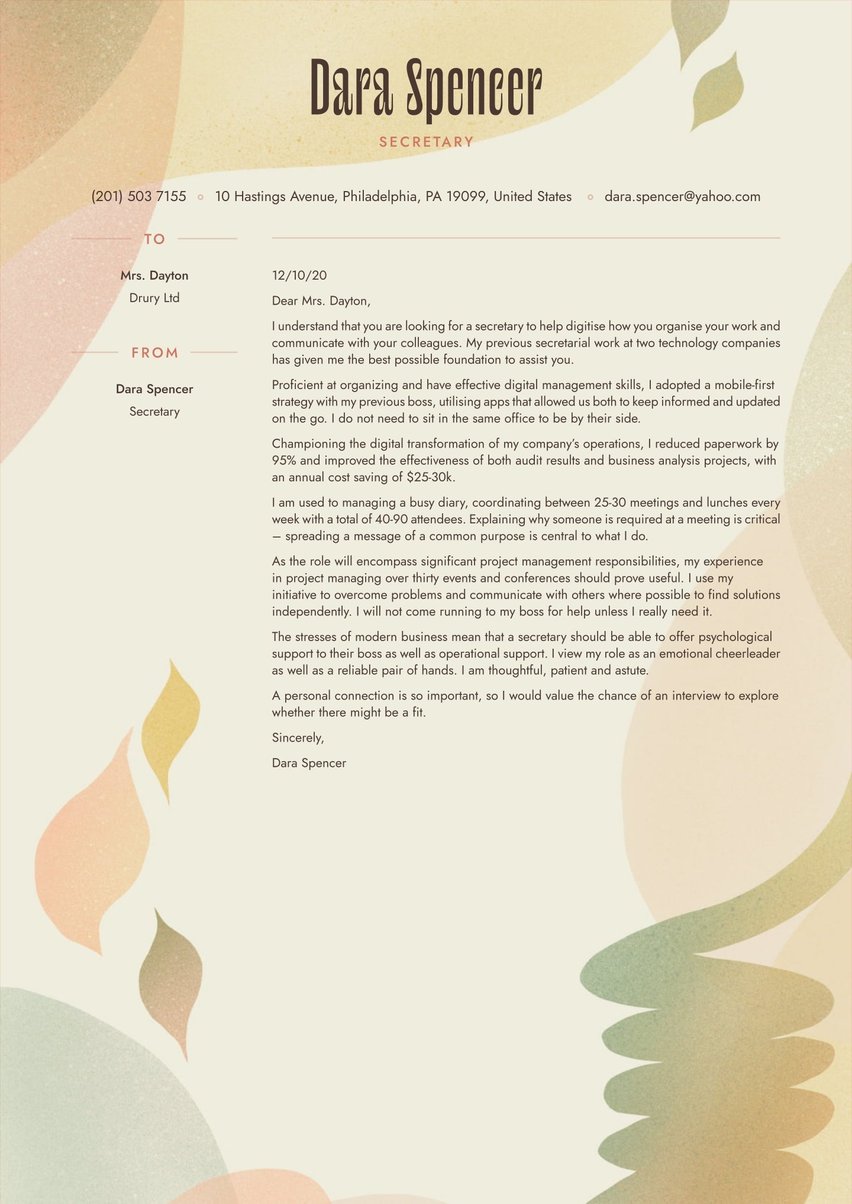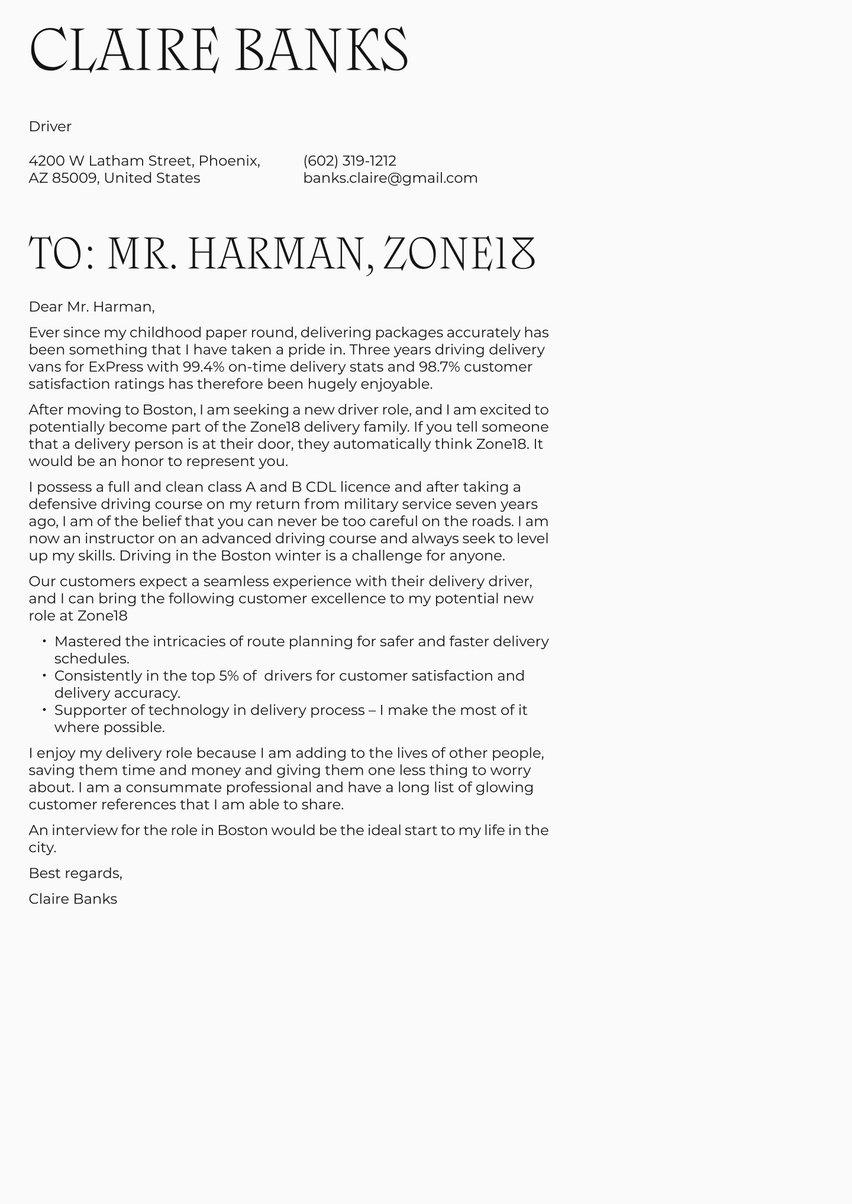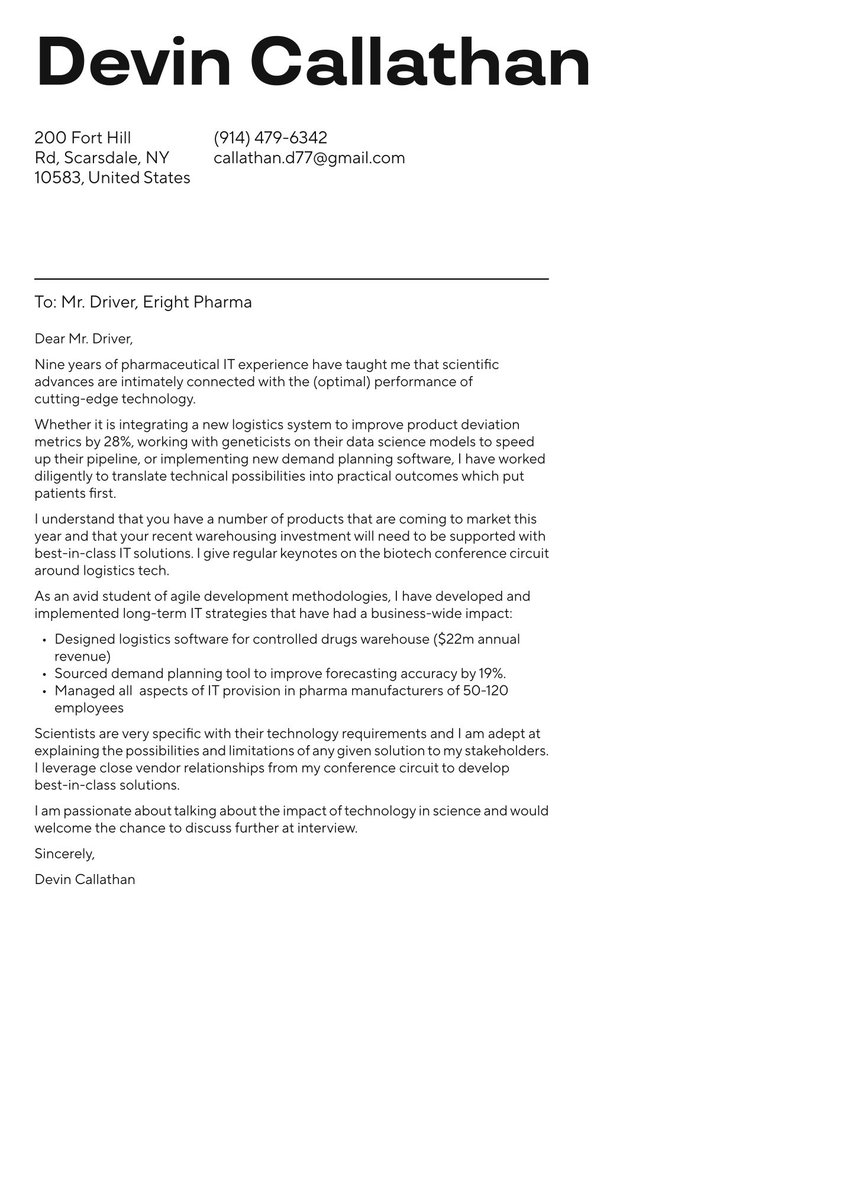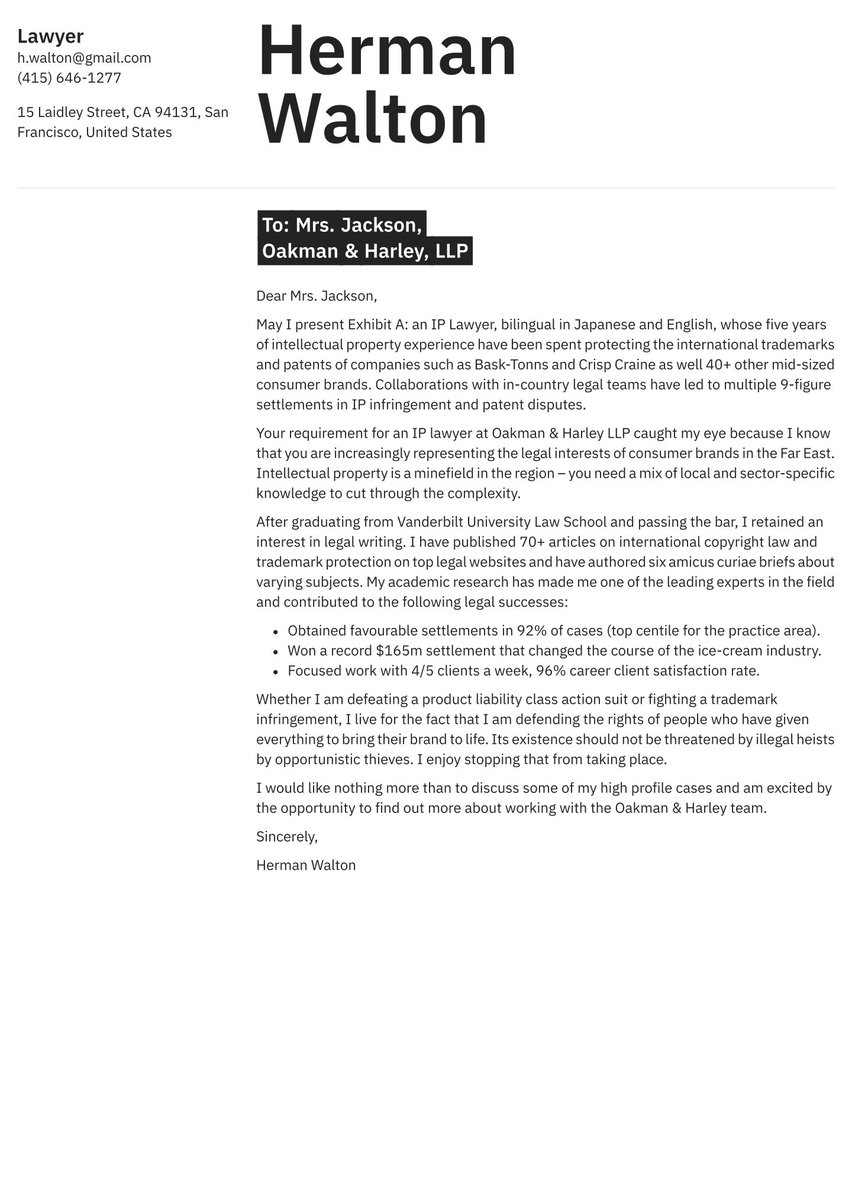You know that hunting for a job requires you to put your best self out there. Your cover letter has the potential to give your prospective employer a feel for who you are and what you’ll bring to the organization.
You have a resume you’re proud of, but the cover letter can be a more challenging task because it is completely open-ended…or is it?
In this guide, which is paired with an expert-written cover letter example, you will learn how to grab the attention of recruiters so that you get that interview.
General full text-only cover letter example
Dear Mr. North,
My experience of managing teams through change has taught me that if you put people first, everything else will fall into place. I led a team through a turbulent 18 months of downsizing at Labsworth, while a blistering period of growth at Pine Inc. provided an entirely different experience. No matter what the trajectory of the company is, there are lessons to be learned.
Upon the completion of my MBA last year, I understood that I wanted to pursue a management role with an international dimension. I have never used my native Spanish in a business context and feel that your expansion into South America will allow me to employ my change management skills in a cultural setting that is familiar to me.
In a start-up, it is important to employ people with both operational and commercial expertise. I have negotiated contracts worth $9.5m, improved delivery efficiencies by 12%, redesigned warehouse packing flows, overseen staff disputes, and driven profitability to industry-leading levels. In my last year at Pine, I spearheaded three initiatives to improve the net profit from 5.2% to 6.1%. Profits improve when everything is considered.
I believe in letting my teams dictate the direction of their development. I have experience working with HR to design training modules, something that is particularly useful in a start-up. I enjoy the creativity and challenge of working out how to get the most out of a diverse set of professionals. 60% of my former team have enjoyed promotions over the past five years.
I cannot wait to find out more about your international expansion plans and hope that I am well-placed to assist.
Sincerely,
Lara Fernandez
Sections of a cover letter
The main purpose of a cover letter is to round out the basic information you provided in your resume. Within that document, you have only 3-4 lines to express your personality in complete sentences and one or two pages to detail the last decade of your working life.
Each portion shows a hiring manager why you are the right fit for the job:
- Cover letter header. The first thing a hiring manager should see is your contact details and the date. This is your way of introducing yourself to the company.
- Greeting. When possible, greet the hiring manager by name to show you care about the position and the company. Often, you’ll need to research the role to find this information.
- Introduction. This is where you catch the attention of the hiring manager and show them why you are excited about the role.
- Body. The body is where you begin showing you are a strong candidate. Include specific examples that demonstrate your qualifications and skills and show how they align with the job requirements.
- Conclusion. Along with including a call to action, your conclusion should show your enthusiasm for the role and tie your experience mentioned in the body back to the opening.
- Signature. The last section of your cover letter should be a professional closing and signature, such as “Best regards, [Your Name]”.
Your goal is to show how the skills from your old career translate to the one you’re embarking on now, or simply why this job at this company. Any cover letter you write should be concise–one page is all you need.
Looking for even more inspiration? Check out our other related cover letter examples that you can adapt to create your cover letter:
Introduction of a cover letter
This paragraph serves as far more than an introduction to your career. It is the attention-getter that leaves them wanting more.
Right off the bat, you need to set a professional tone. Depending on your career, you may need to be precise and serious or a bit playful and creative. An emotional and passionate tone is appropriate for an elementary school teacher, for example, but not for a bank loan officer.
Dear Ms. Johnson,
I am writing to express my interest in the Marketing Coordinator position. With a Bachelor’s degree in Marketing and three years of experience in digital marketing, I am confident in my ability to contribute to your team. I’m particularly interested in your company’s approach to marketing and am eager to bring my experience in social media strategy to your organization.
To whom it may concern,
I am writing to apply for the job you posted. I don’t have much experience in the industry, but I think it will be a good opportunity for me. Some of my skills may be useful, so I hope you consider my application.
The aim of the cover letter intro is to put your most important message out front in a tone that matches that of your profession and the company. Leave them wanting more.
Dear Mr. North,
My experience of managing teams through change has taught me that if you put people first, everything else will fall into place. I led a team through a turbulent 18 months of downsizing at Labsworth, while a blistering period of growth at Pine Inc. provided an entirely different experience. No matter what the trajectory of the company is, there are lessons to be learned.
Cover letter body
You’ve reached the heart of your generic cover letter. Within the cover letter body, you will build on the message you delivered in your intro:
- Choose your greatest achievement—the one where you increased company profits and earned accolades—and detail it.
- Demonstrate how you will fit in with the company’s existing culture and environment.
- Include a conclusion that leaves the hiring manager wanting to learn more.
- Add a call to action that compels a hiring manager to call you for an interview.
First body paragraph: your suitability for the role (skills & experience)
This is where you begin convincing a hiring manager that you’re the right candidate for the job. You can do that by explaining the situations you faced, the actions you took (giving proper credit to others on your team), and your outstanding results while taking care to describe the soft skills as well as the hard skills you used to accomplish this success.
Not sure how to pull that off? Here are the elements you should consider including in your first body paragraph.
- Education and credentials. If you have a degree, mention it in the very first sentence along with any relevant certifications and credentials.
- Mention relevant skills. Adapt your cover letter around the skills that will make you most effective in this role. You can get inspired by reviewing the job description. In your first paragraph, include the top skills you have that will be important in this role.
- Industry technology knowledge. If you are applying for an industry that uses specific tools or technology, include the ones you are experienced with using in your opening paragraph.
- Your portfolio. Your portfolio, if career-appropriate, will play a big role. (Make sure you link to it from your resume or cover letter using an online builder tool, such as the one from Resume.io.)
- Career achievements. To avoid a dense page of type, you may choose to enumerate several career achievements in a bulleted list.
- Accomplishment examples. Back up the assertions you made in your introduction and broaden your list of accomplishments to form a convincing argument for employment.
Your resume and cover letter are part of a complete application package so they should have a cohesive look. Coordinate the fonts and colors you use in all your documents. That looks more professional, but also means that if the pages in your file get separated, they are easily reunited.
If you don’t want the hassle of formatting and designing your application, try a tool builder, such as the one at Resume.io, which offers resume templates and cover letter templates to match.
Second body paragraph(s): alignment with the organization
Once you’ve laid out your skills and accomplishments in the first paragraph of your body, it’s time to show how they will benefit you in the role you are applying for.
You’ll also want to demonstrate how your values can align with the expectations and needs of the company as well as how you will fit in with the culture already in place.
Let’s look at a real-world example of how this might work. Using a startup manager position for reference, let’s look at some elements from the job description:
- Possess both operational and commercial expertise.
- Improve delivery efficiencies.
- Design warehouse packing flows.
- Oversee staffing disputes.
For someone interested in working in a startup, the second paragraph of their cover letter might look something like what you see below.
Upon the completion of my MBA last year, I understood that I wanted to pursue a management role with an international dimension. I have never used my native Spanish in a business context and feel that your expansion into South America will allow me to employ my change management skills in a cultural setting that is familiar to me.
In a start-up, it is important to employ people with both operational and commercial expertise. I have negotiated contracts worth $9.5m, improved delivery efficiencies by 12%, redesigned warehouse packing flows, overseen staff disputes, and driven profitability to industry-leading levels. In my last year at Pine, I spearheaded three initiatives to improve the net profit from 5.2% to 6.1%. Profits improve when everything is considered.
I believe in letting my teams dictate the direction of their development. I have experience working with HR to design training modules, something that is particularly useful in a start-up. I enjoy the creativity and challenge of working out how to get the most out of a diverse set of professionals. 60% of my former team have enjoyed promotions over the past five years.
Call to action & conclusion: End on a high note
Before you sign off, make sure you clearly express your desire for the interview with a call to action. Keep it simple and don’t make assumptions. For example, “when I meet you in the interview” is a little presumptuous.
The goal of the conclusion: Remind the hiring manager of your message, leave them curious, and politely request an interview.
I cannot wait to find out more about your international expansion plans and hope that I am well-placed to assist.
Sincerely,
Lara Fernandez
Key takeaways
Keep your main goal in mind: get that interview. To do that, answer the question “Why are you the best person for the job?” Maintain a consistent tone throughout and make sure it matches the culture of the company to which you are applying.
Filling a blank screen with an outstanding cover letter is no easy task, but Resume.io’s cover letter builder eases the task. Using the tips and tricks you learned in this guide, you may simply click on one of our ready-made and carefully market-researched cover letter templates and start writing.


